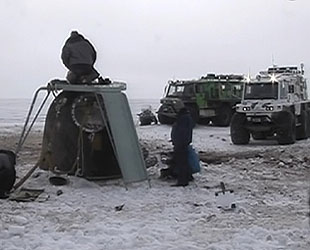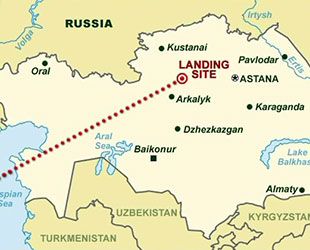March 15, 2013 — An astronaut and two cosmonauts are now back on Earth, having spent the last five months off the planet performing science and maintenance aboard the International Space Station (ISS).
NASA astronaut Kevin Ford, together with Oleg Novitskiy and Evgeny Tarelkin of the Russian federal space agency Roscosmos, touched down Friday (March 15) on the frigid, cloud- and fog-cloaked steppe of Kazakhstan, northeast of the remote town of Arkalyk.
Descending under parachute aboard Russia's Soyuz TMA-06M spacecraft, the crew safely landed around 11:08 p.m. EDT (0308 GMT) or about an hour and a half after sunrise on Saturday (March 16) at the central Asia landing site.
The trio's landing came a day later than originally planned after inclement weather postponed the staging of Russian recovery forces in Kazakhstan. Poor weather continued to be an issue despite the landing proceeding, as low clouds reduced visibility to the point that only two of the recovery team's helicopters could make it to the crew.

Soyuz TMA-06M landed upright on the frigid Kazakh steppe under a thick layer of fog and low clouds on March 15, 2013. (NASA TV) |
Ford, Novitskiy and Tarelkin launched to the station Oct. 23 from the Baikonur Cosmodrome in Kazakhstan, arriving at the orbiting complex two days later. They initially joined the ISS Expedition 33 crew as flight engineers before Ford took over command of Expedition 34 in November.
Under Ford's lead, the space station's crew carried out an almost unprecedented number of science experiments and set a new record for the most science performed during a set time period. The crew also oversaw the arrival of the second U.S. commercial cargo delivery aboard a SpaceX Dragon capsule flown under a contract for NASA.
Novitskiy and Tarelkin both logged a total of 144 days off the planet during this, their first spaceflight. Ford's time in space is now 158 days, including the 14 days he served in 2009 as pilot of the shuttle Discovery's STS-128 mission.
During their residency aboard the station, the three Soyuz TMA-06M crewmates logged nearly 61 million miles in the course of 2,304 orbits around the Earth.

Map showing Soyuz TMA-06M's targeted landing site. (NASA TV) |
Expedition 34 formally came to a close at 7:43 p.m. EDT (2343 GMT) Friday, when the crew separated Soyuz TMA-06M from the Russian Poisk module while flying 263 miles (424 kilometers) over northeastern Mongolia.
The Soyuz capsule's undocking officially marked the start of Expedition 35 under the command of Canadian Space Agency astronaut Chris Hadfield — the first Canadian to lead a space mission — who is scheduled to stay on the orbiting outpost with NASA astronaut Tom Marshburn and Roscosmos cosmonaut Roman Romanenko through May. The three arrived at the space station aboard Soyuz TMA-07M in December.
ISS Expedition 35 will remain as a three-person crew until March 28, when Chris Cassidy of NASA and Roscosmos cosmonauts Pavel Vinogradov and Alexander Misurkin will launch and dock at the space station on the same day, a first for crewed flights to the international complex.
The Soyuz TMA-06M crew members, now safely back on Earth, were being flown by helicopter to the nearby town of Kostanai. From there, Ford was scheduled to return to the Johnson Space Center in Houston on a NASA jet while Novitskiy and Tarelkin head back to Star City, outside of Moscow.
